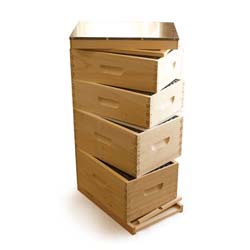Monitor and Manage Varroa Mites
Fall preparation is all about setting up healthy winter (diutinus) bees, managing pests, and making sure your hives have enough stores to last until spring. Varroa mites are one of the greatest threats to honey bees, and managing them effectively is essential for winter survival. Summer is an important time to monitor mite levels, but many treatments can’t be used while honey supers are on since some mite treatments contain chemicals that are not meant for human consumption or could be harmful, even in trace amounts – not to mention temperature restrictions that many treatments have which can be an issue during summer. The key is finding a balance – keeping mite levels under control even during the honey flow. Some treatments are safe to use with supers in place but always read the labels carefully and choose what’s best for your situation. Once harvest is complete, you’ll have more treatment options available to reduce mite loads before winter.
The timing of treatment matters more than anything else. Varroa mites don’t just weaken a few bees – they affect the entire colony, from larvae to the oldest foragers. Their greatest damage comes in late summer and early fall, when colonies are raising bees of winter physiology or “winter bees“. These bees are built to survive for several months – so they can sustain the cluster until spring. If they are weakened by mites and the viruses they spread, their lifespans are cut short. Instead of living into March or April, they may die by January, leaving the colony unable to bridge the gap to spring forage.
Brood production slows in fall and typically stops during winter, limiting their ability to reproduce (queens will usually start laying again late February to early March). Varroa mites take advantage of this and – if not kept under control – can quickly outnumber the honey bees in the colony. The real danger is that viruses transmitted earlier in the season continue to weaken the bees. Colonies going into winter with sick or shortened-lived bees are far less able to survive the stress of cold, confinement, and dwindling resources. Treating at the right time ensures your winter bees are as healthy as possible before brood production slows down.
Feed Colonies After Harvest
After honey supers come off, feeding becomes an important tool for preparing your hives. If you’re planning on harvesting honey you don’t want to feed while honey supers are on, since syrup and other supplements can end up mixed into your harvested honey. Once harvest is done, though, it’s time to pay close attention to hive weight.
Your colonies need plentiful stores to carry them through winter. If you’ve pulled too much honey, or if natural nectar sources are in decline, begin supplemental feeding. This not only ensures your bees have enough food but also reduces the stress of scarcity, helping them focus on building up for winter.
Limit Hive Disturbance
After harvest, try to minimize how often you open your hives. Natural nectar flows are tapering off, and bees may become more defensive and protective of their stores. Quick, purposeful inspections are best. The less you disturb them during this period, the better they can focus on preparing for winter.
Store and Protect Your Equipment
Good equipment care is just as important as caring for your bees. Drawn comb and frames should be stored properly after harvest to protect them from pests. Freezing frames for a time kills off wax moth and small hive beetle eggs and larva. If you have frames with capped honey, you can store them in weatherproof containers to feed back to your bees later in the season. Having extra honey frames on hand can be a lifesaver if a colony runs light in the middle of winter.
Final Thoughts
Honey harvest isn’t the end of the beekeeping season – it’s the turning point toward winter preparation. By monitoring and treating for varroa mites at the right time, ensuring colonies have enough food, minimizing stress, and protecting your equipment, you give your bees their best chance of survival. Healthy fall colonies build strong winter bees, and strong winter bees carry your apiary into a thriving spring.
